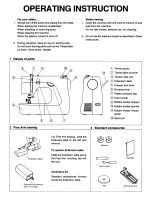
———————————————————————————————————————————————————————————————
64
T
thick fabrics....................................................................30
thin fabrics .....................................................................31
thread cutter...................................................................29
thread guide ...................................................................16
thread tension ................................................................29
trial sewing.....................................................................30
triple stretch stitch ..........................................................33
troubleshooting ..............................................................59
twin needle ....................................................................22
U
upper tension-control dial ..............................................29
upper threading..............................................................16
W
walking foot ...................................................................44
wing needle ...................................................................51
Z
zigzag stitch .....................................................30
,
32
,
42
zipper foot......................................................................40
zipper Insertion ..............................................................40
NCBC2000.book Page 64 Thursday, October 21, 2004 4:32 PM


































